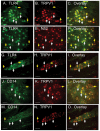Trigeminal nociceptors express TLR-4 and CD14: a mechanism for pain due to infection
- PMID: 16373680
- PMCID: PMC2227946
- DOI: 10.1177/154405910608500108
Trigeminal nociceptors express TLR-4 and CD14: a mechanism for pain due to infection
Abstract
Although certain bacterial species appear to be risk factors for pain due to odontogenic infections, comparatively little is known about the potential mechanisms mediating this effect. In this study, we tested the hypothesis that trigeminal nociceptive neurons express the TLR4 or CD14 receptors, thus enabling sensory neurons to detect and respond to tissue levels of bacterial substances such as lipopolysaccharide (LPS). Immunohistochemical analyses of human and rat trigeminal neurons demonstrated that a capsaicin-sensitive subclass of nociceptors (defined by expression of TRPV1, a capsaicin receptor) expresses both TLR4 and CD14. Moreover, human dental pulp collected from patients with caries lesions demonstrated co-localization of TLR4 and CD14, with markers of peripheral sensory neurons. Collectively, these studies indicate that the capsaicin-sensitive subclass of trigeminal nociceptors expresses TLR4 and CD14. These results indicate that pain due to bacterial infections may result, in part, from direct activation of nociceptors by bacterial products such as LPS.
Figures


References
-
- Aksoy E, Goldman M, Willems F. Protein kinase C epsilon: a new target to control inflammation and immune-mediated disorders. Int J Biochem Cell Biol. 2004;36:183–188. - PubMed
-
- Bowles WR, Flores CM, Jackson DL, Hargreaves KM. Beta 2-adrenoceptor regulation of CGRP release from capsaicin-sensitive neurons. J Dent Res. 2003;82:308–311. - PubMed
-
- Byers MR, Taylor PE. Effect of sensory denervation on the response of rat molar pulp to exposure injury. J Dent Res. 1993;72:613–618. - PubMed
-
- Caterina MJ, Schumacher MA, Tominaga M, Rosen TA, Levine JD, Julius D. The capsaicin receptor: a heat-activated ion channel in the pain pathway. Nature. 1997;389:816–824. - PubMed
Publication types
MeSH terms
Substances
Grants and funding
LinkOut - more resources
Full Text Sources
Other Literature Sources
Medical
Research Materials

